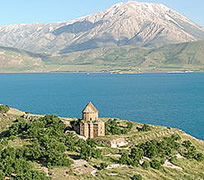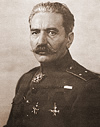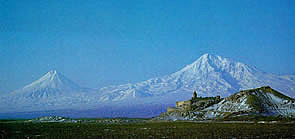Glossary (Akhtamar-Argiste)
Akhtamar
 Cathedral of Holy Cross was restored as museum by Turkish government, in 2006.
Cathedral of Holy Cross was restored as museum by Turkish government, in 2006.
Island on the Van Lake in historical Vaspurakan province of Armenia (now in Turkey). In 915-921, the sumptuous Church of Holy Cross and the royal palace were built here by the architect Manuel under the auspices of King Gagik Ardzrouni. In 1113, The Church of Holy Cross became the residence of the Catholicos of Akhtamar.
Alexandropol
Present day Gyumri, former Leninakan (1924-1991), second large city of the Republic of Armenia, situated 53m (85km) northwest of Yerevan. In 1988, the half of the city was destroyed by the devastating earthquake.
Alishan, Ghevond
 Ghevond Alishan
Ghevond Alishan
(1820-1901) Outstanding scholar, historian and poet. Ordained catholic priest at the age of 14, he became member of the Mkhitarists Congregation in Venice. In 1849, he headed the Bazmavep periodical. His capital works of history, ethnography and geography, as well as his patriotic poetry had great influence on young Armenian students. He was conferred Legion of Honor in 1866.
Anania Shirakatsi
(610-685) Illustrious Armenian scholar, mathematician and geographer. His most famous works are Geography Guide, and Cosmography.
Ananun
(Armenian for Nameless) Son of King Abgar. He succeeded his father as ruler of Edessa in AD 34. At the same time, his cousin Sanatruk was crowned King of the Greater Armenia. Both apostates of Christianity adopted by King Abgar, they worshipped the ancient gods, and persecuted Christians in both Greater and Lesser Armenias. Tradition has it that the Apostles Judas, Thaddeus and Bartholomew were killed in different regions of Armenia during the ruling of Ananun and Sanatruk.
Ani
 Church of St.Gregory in Ani built in the 10th century by Princes of Aboughamrents House.
Church of St.Gregory in Ani built in the 10th century by Princes of Aboughamrents House.
Castle and city in the western part of Shirak province of Armenia (now in Turkey), Ani was mentioned in different primary sources from the 5th century. By the 10th century, Ani became a rich city of prosperous trade, commerce and culture. The kings of Bagratouni dynasty made it their capital. Historians of different times termed Ani as The Glorious City, The city of 1001 churches and The Mother of the Armenian Cities.
Andranik
 Andranik
Andranik
(1865-1927) Andranik Ozanian, outstanding leader of the Armenian liberation movement, general, political and public activist and freedom fighter. During the Balkan Wars in 1912-1913, he fought for Bulgarians against the Ottoman Empire. Then he returned to Armenia to organize the Armenian volunteer units to battle the Turkish regular army. After the fall of the Republic of Armenia, he immigrated to America, and died in Fresno, California, in 1927. His remains were taken to Paris in 1928, and finally brought to Armenia in 1999.
ANM
Pan-Armenian National Movement, or Armenian All-National Movement. Formed in November of 1989 by leaders of Karabakh Committee, AMN was the leading political party in Armenia from 1990 to 1998.
Aram, King
King of the Kingdom of Ararat (860-840 BC). The name Armenia is believed to be derived from Aram.
Aran
Nicknamed Aghu (Kind, Gentle), Aran was an Armenian prince appointed by King Vagharshak as governor of Eastern provinces in the 2d century BC. Aghuank is named after him (see Aghuank).
Ararat
 View of Mount Ararat from Armenia
View of Mount Ararat from Armenia
Mountain in Armenia (present-day East Turkey), with two peaks, Little Ararat (12,877ft or 3,925m) and Great Ararat (16,945ft or 5,165m). According to Bible, Ararat was resting place of Noah’s ark (Genesis 8, 4).
Ara the Beautiful
Son of Aram and father of Kardos, he ruled the Kingdom of Ararat from 1769 to 1743 BC. His name is famous in Armenian and foreign legends and popular songs.
Ardahan
City in the former Kars region of Armenia (present-day northeastern Turkey). In 1878, the Turks ceded Ardahan with the rest of the Kars region to Russia, but annexed it again in 1921.
Argiste
(Argiste I), King of Armenia (786-765 BC) of Arartouni dynasty. He founded the fortress of Yerevan, in 782 BC, and the city of Argistehinili, in 776 BC.







